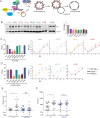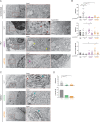Differential and convergent utilization of autophagy components by positive-strand RNA viruses
- PMID: 30608919
- PMCID: PMC6334974
- DOI: 10.1371/journal.pbio.2006926
Differential and convergent utilization of autophagy components by positive-strand RNA viruses
Abstract
Many viruses interface with the autophagy pathway, a highly conserved process for recycling cellular components. For three viral infections in which autophagy constituents are proviral (poliovirus, dengue, and Zika), we developed a panel of knockouts (KOs) of autophagy-related genes to test which components of the canonical pathway are utilized. We discovered that each virus uses a distinct set of initiation components; however, all three viruses utilize autophagy-related gene 9 (ATG9), a lipid scavenging protein, and LC3 (light-chain 3), which is involved in membrane curvature. These results show that viruses use noncanonical routes for membrane sculpting and LC3 recruitment. By measuring viral RNA abundance, we also found that poliovirus utilizes these autophagy components for intracellular growth, while dengue and Zika virus only use autophagy components for post-RNA replication processes. Comparing how RNA viruses manipulate the autophagy pathway reveals new noncanonical autophagy routes, explains the exacerbation of disease by starvation, and uncovers common targets for antiviral drugs.
Conflict of interest statement
The authors have declared that no competing interests exist.
Figures







Similar articles
-
Dengue and Zika viruses subvert reticulophagy by NS2B3-mediated cleavage of FAM134B.Autophagy. 2017 Feb;13(2):322-332. doi: 10.1080/15548627.2016.1265192. Epub 2017 Jan 19. Autophagy. 2017. PMID: 28102736 Free PMC article.
-
RNA Helicase A Is an Important Host Factor Involved in Dengue Virus Replication.J Virol. 2019 Feb 5;93(4):e01306-18. doi: 10.1128/JVI.01306-18. Print 2019 Feb 15. J Virol. 2019. PMID: 30463971 Free PMC article.
-
Establishment and Application of Flavivirus Replicons.Adv Exp Med Biol. 2018;1062:165-173. doi: 10.1007/978-981-10-8727-1_12. Adv Exp Med Biol. 2018. PMID: 29845532 Review.
-
Zika Virus Induces Autophagy in Human Umbilical Vein Endothelial Cells.Viruses. 2018 May 15;10(5):259. doi: 10.3390/v10050259. Viruses. 2018. PMID: 29762492 Free PMC article.
-
Viral Entry and NS1 as Potential Antiviral Drug Targets.Adv Exp Med Biol. 2018;1062:107-113. doi: 10.1007/978-981-10-8727-1_8. Adv Exp Med Biol. 2018. PMID: 29845528 Review.
Cited by
-
Mechanistic Target of Rapamycin Signaling Activation Antagonizes Autophagy To Facilitate Zika Virus Replication.J Virol. 2020 Oct 27;94(22):e01575-20. doi: 10.1128/JVI.01575-20. Print 2020 Oct 27. J Virol. 2020. PMID: 32878890 Free PMC article.
-
A Conserved Cysteine Residue in Coxsackievirus B3 Protein 3A with Implication for Elevated Virulence.Viruses. 2022 Apr 7;14(4):769. doi: 10.3390/v14040769. Viruses. 2022. PMID: 35458499 Free PMC article.
-
Manipulation of autophagy by (+) RNA viruses.Semin Cell Dev Biol. 2020 May;101:3-11. doi: 10.1016/j.semcdb.2019.07.013. Epub 2019 Aug 8. Semin Cell Dev Biol. 2020. PMID: 31382014 Free PMC article. Review.
-
MicroRNA-194-3p impacts autophagy and represses rotavirus replication via targeting silent information regulator 1.Virol J. 2023 Sep 11;20(1):210. doi: 10.1186/s12985-023-02175-z. Virol J. 2023. PMID: 37697309 Free PMC article.
-
Non-lytic spread of poliovirus requires the nonstructural protein 3CD.mBio. 2025 Jan 8;16(1):e0327624. doi: 10.1128/mbio.03276-24. Epub 2024 Dec 12. mBio. 2025. PMID: 39665531 Free PMC article.
References
Publication types
MeSH terms
Substances
Grants and funding
LinkOut - more resources
Full Text Sources
Other Literature Sources
Molecular Biology Databases
Research Materials

